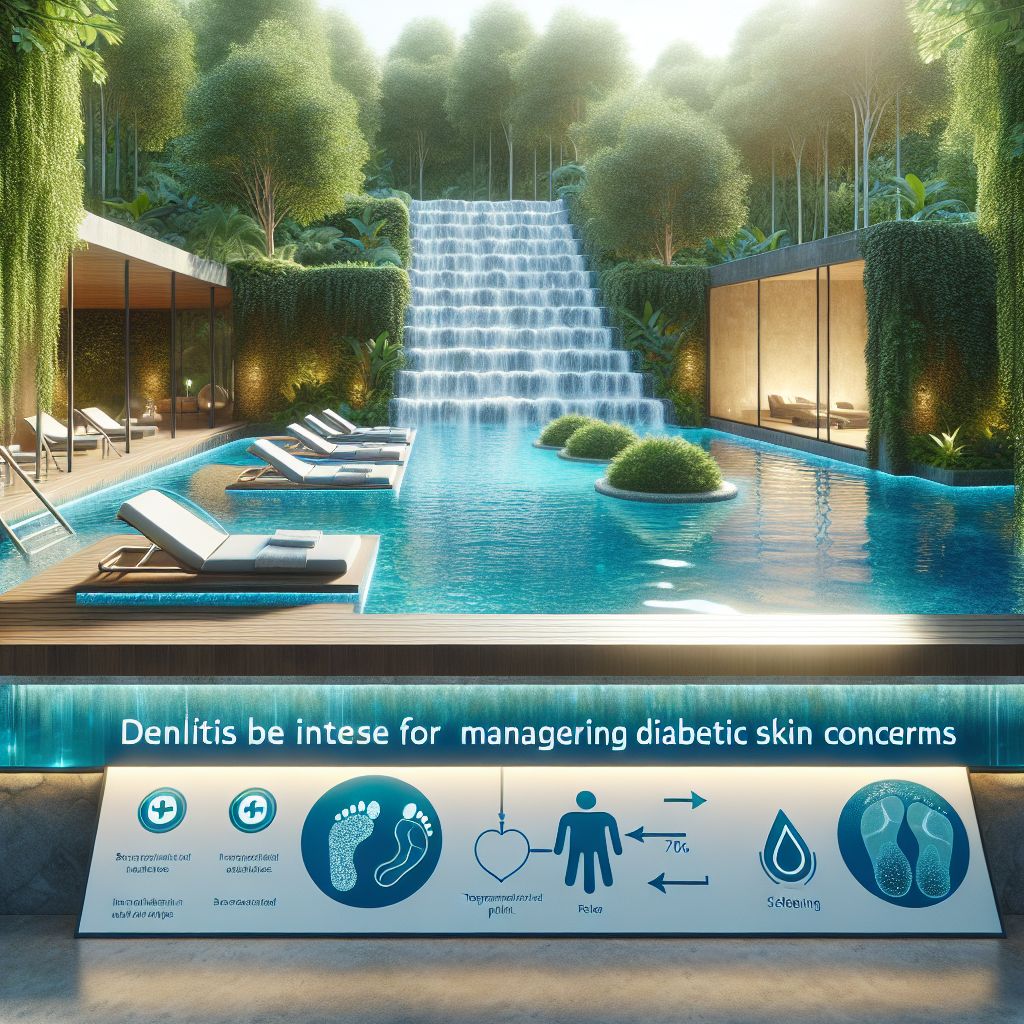
-
Hydrotherapy pools can improve blood circulation and skin health for diabetics.
-
Choosing the right hydrotherapy pool involves considering accessibility, water temperature, and additional therapeutic features.
-
Diabetics must monitor blood sugar levels and be aware of infection risks when using hydrotherapy pools.
-
Regular maintenance of hydrotherapy pools ensures safety and effectiveness for diabetic skin concerns.
-
Real-life testimonials highlight the benefits of hydrotherapy pools for managing diabetic skin conditions.
The Therapeutic Power of Hydrotherapy Pools
When it comes to managing diabetes, every little aspect of your health routine matters. One therapeutic option that might not immediately come to mind is the use of hydrotherapy pools. For those unfamiliar, hydrotherapy involves the use of water for pain relief and treatment. It’s not just about soaking in a warm bath—hydrotherapy pools are engineered to provide benefits that go beyond relaxation, especially for those with diabetes.
Understanding Hydrotherapy and Its Benefits for Diabetics
Diabetes can affect the body in various ways, and one area of concern is skin health. Diabetic skin can be more prone to dryness, infections, and poor circulation. This is where hydrotherapy pools come into play. The warm water helps to open blood vessels, improving circulation and nutrient delivery to the skin. This can help in healing and maintaining healthy skin. Moreover, the buoyancy of water reduces stress on the body, allowing for gentle exercise that can be particularly beneficial for those with diabetic neuropathy.
How Warm Water Can Enhance Diabetic Skin Health
Warm water therapy in a hydrotherapy pool can do wonders for diabetic skin. The warmth aids in vasodilation—expansion of the blood vessels—which increases blood flow to the skin. This enhanced circulation can help to nourish skin tissues and promote the healing of sores and ulcers, which are common concerns for diabetics. Additionally, the hydrostatic pressure exerted by water can reduce swelling and inflammation, providing relief for painful areas.
Finding the Right Hydrotherapy Pool

So, you’re considering hydrotherapy for your diabetes management plan—great! But before you dive in, it’s essential to find a pool that fits your specific needs. Not all hydrotherapy pools are the same, and the features you’ll need can vary depending on your diabetic condition and the state of your skin.
Factors to Consider When Choosing a Pool
When you’re on the hunt for the perfect hydrotherapy pool, keep these factors in mind:
-
Size and Depth: The pool should be large enough for you to move comfortably and perform exercises if needed.
-
Temperature Control: A pool that maintains a consistent warm temperature is ideal for diabetic skin care.
-
Hydrotherapy Features: Look for pools with jets and adjustable settings to target specific areas of your body.
-
Sanitation: Cleanliness is crucial, especially for diabetics, to prevent infections.
Choosing the right pool can make all the difference in the effectiveness of your hydrotherapy sessions.
Accessibility Features for Diabetics
Accessibility is another key factor to consider, especially if you have mobility issues. Look for pools with features such as:
-
Handrails for safe entry and exit
-
Steps or ramps that are easy to navigate
-
Wheelchair-friendly designs
These features ensure that you can enjoy the benefits of hydrotherapy safely and with ease.
Water Quality and Filtration Systems
When selecting a hydrotherapy pool, the quality of water is paramount. Remember, you’re managing diabetes, and your skin requires the utmost care. Therefore, the pool must have an advanced filtration system that ensures the water is free from bacteria and other contaminants. This is crucial because infections are a serious risk for diabetic skin.
Look for pools with a robust filtration system that includes:
-
A high turnover rate to constantly refresh the water
-
UV disinfection to kill off harmful microorganisms
-
Ozone or saltwater systems that provide gentle sanitation without harsh chemicals
Good filtration systems not only protect your skin but also improve the overall hydrotherapy experience by keeping the water crystal clear and odor-free.
Additional Therapeutic Elements
Besides the basics, many hydrotherapy pools come with additional therapeutic elements designed to enhance your healing experience. These can include:
-
Air jets that provide a gentle massage, stimulating the skin and underlying tissues
-
Built-in seats and loungers for comfortable, extended therapy sessions
-
Variable water currents that allow for resistance exercises to improve circulation further
These features are not just bells and whistles; they play a crucial role in the effectiveness of your hydrotherapy sessions.
Hydrotherapy Pool Safety for Diabetics
Safety should be your top priority when it comes to hydrotherapy. For diabetics, this means being vigilant about blood sugar levels and potential infection risks.
Monitoring Blood Sugar Levels During Hydrotherapy
Before you step into the water, check your blood sugar. Hydrotherapy can affect your glucose levels, and it’s essential to ensure they’re stable beforehand. If you’re engaging in physical activity in the pool, you might need a snack to prevent hypoglycemia. Always have a plan for monitoring your blood sugar during and after your pool sessions.
Recognizing and Managing Risks of Infection
Because diabetes can impair your immune system, you must be extra careful to avoid infections. Always inspect your skin for cuts or abrasions before using a hydrotherapy pool. If you find any, cover them securely with a waterproof dressing. Additionally, after each session, wash your skin with mild soap and inspect it again for any signs of irritation or infection.
-
Shower before and after using the pool to minimize the risk of infection
-
Avoid hydrotherapy if you have open wounds or active infections
-
Choose pools that maintain proper chlorine levels and pH balance to inhibit bacterial growth
By taking these precautions, you can enjoy the benefits of hydrotherapy without compromising your health.
Maintaining Your Hydrotherapy Pool

Maintaining your hydrotherapy pool is just as important as choosing the right one. Regular cleaning and disinfection are essential to ensure the pool remains a safe and therapeutic environment.
Cleaning and Disinfection Protocols
Whether you own a personal hydrotherapy pool or use one at a facility, it’s crucial to follow strict cleaning protocols. This includes daily checks of water clarity and chemical balance, as well as regular scrubbing of the pool surfaces to prevent biofilm formation. Disinfection routines should be carried out with products that are effective against a broad spectrum of pathogens but are still safe for your skin.
Regular Maintenance Schedules
Along with daily cleaning, schedule regular maintenance to inspect and service the pool’s mechanical and filtration systems. This ensures everything operates efficiently and prevents the buildup of harmful bacteria. Keep a maintenance log to track the cleaning and servicing of the pool, which can be helpful for identifying potential issues before they become serious problems.
Testimonials: Success Stories of Hydrotherapy for Diabetic Skin Health
It’s one thing to read about the benefits of hydrotherapy pools for diabetic skin concerns, but it’s another to hear about real-life successes. Many individuals with diabetes have found significant improvements in their skin’s health and overall well-being through regular hydrotherapy sessions.
Real-life Improvements in Skin Conditions
For example, consider the story of Maria, a 58-year-old with type 2 diabetes. She struggled with recurring skin infections that were slow to heal. After incorporating hydrotherapy into her routine, she noticed a remarkable change. The improved circulation from the warm water sessions helped her skin heal faster, and the infections became less frequent. Maria’s experience is just one of many where hydrotherapy has made a tangible difference in managing diabetic skin conditions.
In conclusion, selecting the right hydrotherapy pool is a thoughtful process that involves considering various factors to ensure safety and maximize therapeutic benefits. By understanding the importance of water quality, additional therapeutic elements, and regular maintenance, you can make an informed decision that supports your diabetic health management. Remember to always monitor your blood sugar levels and be aware of infection risks. With these precautions in mind, hydrotherapy can be a valuable addition to your diabetes care regimen.
-
Hydrotherapy pools can improve blood circulation and skin health for diabetics.
-
Choosing the right hydrotherapy pool involves considering accessibility, water temperature, and additional therapeutic features.
-
Diabetics must monitor blood sugar levels and be aware of infection risks when using hydrotherapy pools.
-
Regular maintenance of hydrotherapy pools ensures safety and effectiveness for diabetic skin concerns.
-
Real-life testimonials highlight the benefits of hydrotherapy pools for managing diabetic skin conditions.
Frequently Asked Questions
With the benefits of hydrotherapy pools for diabetic skin health now clear, let’s address some common questions that may arise as you consider this therapeutic option.
1. How Often Should Diabetics Use a Hydrotherapy Pool?
The frequency of hydrotherapy sessions can vary depending on individual health goals and responses to treatment. Generally, starting with sessions two to three times a week can help gauge how your skin and blood sugar levels react. It’s essential to monitor your skin for any adverse reactions and consult with your healthcare provider to tailor a schedule that suits your specific needs.
2. What Precautions Should Diabetics Take Before Using a Hydrotherapy Pool?
Before stepping into a hydrotherapy pool, diabetics should:
-
Check their blood sugar levels to ensure they are within a safe range.
-
Inspect their skin for any cuts, wounds, or infections and cover any open areas with a waterproof dressing.
-
Consult with their healthcare provider, especially if they have any complications related to diabetes.
Additionally, it’s vital to stay hydrated and have a plan for monitoring blood sugar levels during and after the session.
3. Can Hydrotherapy Help with Other Diabetic Complications?
Hydrotherapy may provide relief for various diabetic complications, such as neuropathy, by reducing pain and improving circulation. The supportive environment of the water can also aid in gentle exercise, which is beneficial for managing blood sugar levels and improving cardiovascular health. However, it’s important to approach hydrotherapy as part of a comprehensive diabetes care plan and not as a standalone solution.
4. Are There Any Age Restrictions for Using Hydrotherapy Pools?
There are generally no age restrictions for using hydrotherapy pools, but individual facilities may have their own guidelines. For children and elderly individuals with diabetes, special considerations regarding pool depth, temperature, and supervision may be necessary to ensure a safe and beneficial experience.
5. How to Find Accessible Hydrotherapy Pools for Diabetics?
To find an accessible hydrotherapy pool, start by checking local health clubs, rehabilitation centers, or hospitals. Many of these facilities offer pools designed for therapeutic use. Additionally, contacting diabetes support groups or associations can provide recommendations for diabetic-friendly pools in your area. When inquiring about a pool, ask about accessibility features, water quality measures, and any programs specifically tailored for individuals with diabetes.



Leave a Reply